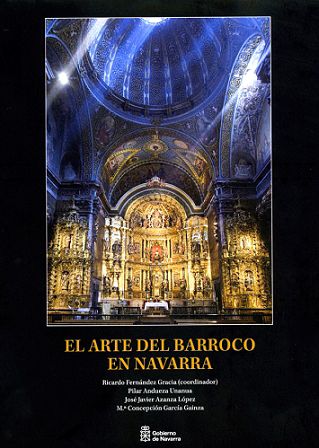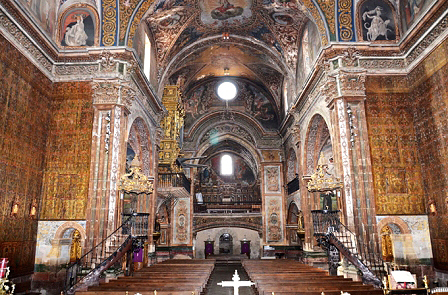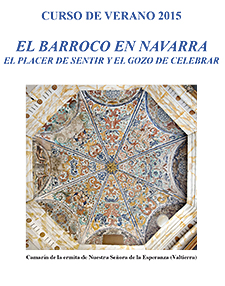THE BAROQUE IN NAVARRA. THE PLEASURE OF FEELING AND THE JOY OF CELEBRATING
September 15, 2015
Does the Baroque exist in Navarre?
D. Ricardo Fernández Gracia. Chair of Heritage and Art of Navarre.
The scarce interest, even contempt, towards the Baroque has been a general fact, more evident if possible in peninsular regions such as Navarre, where the weight of medieval art seduced the first art historians and scholars in general, because it constituted a very outstanding chapter, at the same time that the Foral Community itself saw in those manifestations of the Middle Ages, the evocation of a past to which the reality of the independent Kingdom, before its conquest and incorporation to Castile, was not alien. With a certain disadvantage with respect to the Renaissance, on which Tomás Biurrun y Sotil focused his attention with an already classic book, in 1935, the knowledge of the artistic manifestations of the 17th and 18th centuries started with force, only six lustrums ago.
Last year, in 2014, the monograph on The Art of the Baroque in Navarre was published, coordinated by the writer of these lines, with the participation of Profs. García Gainza, Azanza López and Andueza Unanua. A first synthesis of a period whose artistic manifestations have been the subject of doctoral thesis and different monographs since the last decade of the last century, as a result of several doctoral thesis , monographs and exhibitions that have revealed the existence of what we can expect from a culture and a style: workshops and artists, quality of the works, expansive foci, singular works imported from different peninsular foci, Italy and the Indies, as well as patrons in the form of promoters, patrons and patrons who were aware of their role and of creating a very specific image of power around them.
The answer to the question posed by degree scroll is undoubtedly affirmative. We only have to leaf through the pages of the abundant bibliography that we have today on the period, fruit of solid programs of study made from the discipline of History of Art. The question has been raised because until recently the Navarrese Baroque was not contemplated in the syntheses of the period, partly because of ignorance and partly because of the weight of the derogatory judgments on the artistic manifestations of the 17th and 18th centuries that, as in other regions, began at the end of the Age of Enlightenment.

The Art of the Baroque in Navarre
Ricardo Fernández Gracia (coord.), Pilar Andueza Unanua, José Javier Azanza López and Mª Concepción García Gainza.
Pamplona, Government of Navarra, 2014
The pejorative vision of the arts of the Baroque, in general, and a fortiori of its altarpieces started, as in other places, from the academic criticism and took root widely, reaching practically until the last third of the last century. Don Antonio Ponz, when visiting the churches of Pamplona, left written, in 1785, expressions like these: "I am sorry to have seen in the Parish of San Lorenzo the monstrous ornamentation of the Chapel of San Fermín, and the unspeakable woodwork of the piled up and extravagant altarpieces of San Saturnino. There is nothing reasonable in the Church of Carmen to which to turn our eyes, since starting with the classic monstrosity of the main altarpiece, both in architecture and sculpture, the others follow in the same vein". Regarding the cathedral of Pamplona, after praising the Gothic masonry, the façade project and the main altarpiece, he lashed out against the Baroque works with expressions such as these: "but if they do not remove the ridiculous modern tabernacle -of the main altarpiece- and the rest with which they have filled the space occupied by the old one, they will maintain an insufferable deformity, which is what can be seen in the other altarpieces of the chapels". His appreciations and those of Ventura Rodriguez, author of the project of the neoclassical façade of the cathedral, were reflected in the personality of Don Santos Angel de Ochandátegui, manager in extremis of the disappearance of some altarpieces and grilles, as well as many other transfers and reforms in the interior of the cathedral.
The teachings of the Royal Academy of San Fernando, faithfully followed by Ochandátegui, are perfectly summary in the memorial that he delivered to the Pamplona cathedral chapter, once the façade was finished, in tune with what was advocated by authors such as the Marquis of Ureña. His ideals of cleaning the grilles, baroque altarpieces and various relocations did not take effect for the time being, although they remained underlying until the middle of the last century. In this sense, the works carried out in 1946, with the relocation of the choir stalls, are a clear demonstration of this. Countless projects submitted for the approval of the Royal Academy of San Fernando in the last years of the 18th century, and the assessments of that institution cooperated in the condemnation of many other works in which the Navarrese masters continued to adhere to the Baroque tradition.
All those approaches emanating from the neoclassical critique permeated in Navarre and, very particularly in Pamplona, until recent times, so that the responsibility for the systematic disappearance of the altarpieces and ornamental pieces, such as pulpits and organs of the 17th and 18th centuries, from the churches of Pamplona and Navarre in general, must be sought in them.
A first call for attention was made by prof. García Gainza in a article published in 1975, in the journal Letras de Deusto, where he highlighted the existence of remarkable sets, corresponding to the different phases or stages through which the altarpiece of the seventeenth and eighteenth centuries runs, while claiming for the first time the existence of baroque art in the region, noting: "a careful study of the artistic works of this kingdom, in the seventeenth and eighteenth centuries, highlights the existence of a baroque art, perhaps not as splendid as the Renaissance, but worthy of being taken into account when making the balance of the national baroque" .
Up to that date in 1975, we can only review a very few serious works on reference letter to baroque works. The first of them, published in the bulletin of the Commission of Monuments of Navarre, in 1929, by José María Huarte, was a documentary study on the group of altarpieces of Recoletas of Pamplona. Among the local bibliography , Arrese's programs of study on Corella stands out for its documentary rigor, as well as for its call to attention on the Baroque in a specific locality, an exception worthy of taking into account and valuing in its just measure.

Vault of the "camarín" of Our Lady of the Yoke in Arguedas

The interior decoration of the parish church of Los Arcos is one of the most outstanding examples of Baroque in Navarre.
A very significant fact about the panorama we are describing is that the magazine Príncipe de Viana, which collected so many works on Medieval and Renaissance art, hardly published any serious articles on Baroque works until the 1980s, programs of study .
From the seventies onwards we find works studied and evaluated with a rigorous and serious methodology in the art-historical field, always in research carried out at the department of Art History of the University of Navarra. programs of study by García Gainza focused on the influence of Gregorio Fernández on the plastic arts in Navarra, on other monuments of the regional Baroque and on the altarpieces of LesaKa. Likewise, some thesis of licentiate degree and doctoral studies, which addressed programs of study of temples in their entirety or large monumental ensembles, supported by the aforementioned center professor and directed by the aforementioned professor, began to pay due attention to the works of the Baroque period. In the same way, other works of people trained in the aforementioned department have been dealing with specific aspects or related to the arts of the seventeenth or eighteenth centuries.
At the same time, from 1978 onwards, the collection of data, preparation and publication of the volumes of the Catalog Monumental de Navarra revealed the existence of excellent works and masters in different towns of Navarra. A bibliographic evaluation of the Navarrese Baroque, was carried out by García Gainza in the conference proceedings of the I congress General de Historia de Navarra, while all the contributions, particularly those published in the Catalog Monumental de Navarra, began to bear fruit with echoes at a national level. In the aforementioned synthesis monograph, the reader can follow in more detail the contributions made over the last decades and which have been fundamental in the vindication of the period and its manifestations in the totality of the arts.
PROGRAM
Tuesday, 15th September
The Baroque, an invention of the 20th century?
Javier Portús Pérez. Prado National Museum
Does the Baroque exist in Navarre?
D. Ricardo Fernández Gracia. Chair of Heritage and Art of Navarre
Wednesday, 16th September
"Plegaria de ladrillo y sillar" (Brick and ashlar prayer). Religious architecture in the Navarrese Baroque
Mr. José Javier Azanza López. Chair of Navarrese Heritage and Art
The construction of an image of power: town planning, houses and palaces.
Ms. Pilar Andueza Unanua. Chair of Navarrese Heritage and Art
Thursday, 17th September
Of chisel, hammer and paintbrush. The visual arts at the service of the Church and power
D. Ricardo Fernández Gracia. Chair of Navarrese Art and Heritage.
Jewellery and silver. Adornment and function
Mª Concepción García Gainza. Chair of Heritage and Art in Navarre
presentation of the book Alonso Cano and the Lekaroz Crucifixion
Mª Concepción García Gainza. Chair de Patrimonio y Arte navarro

